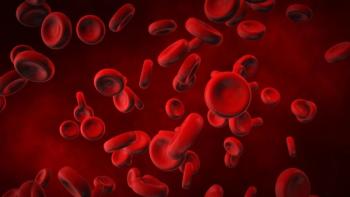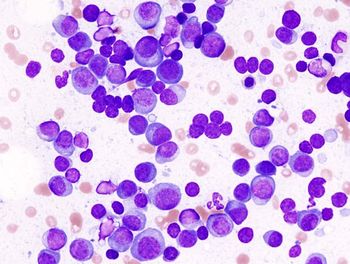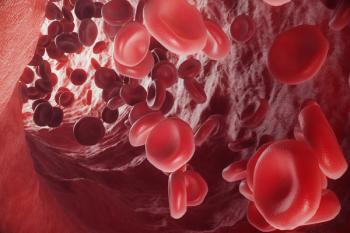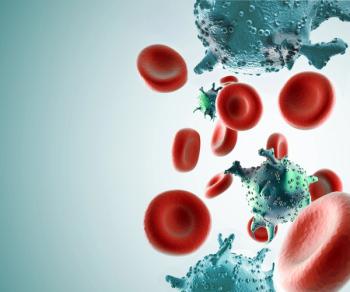
Which Drug Is Contraindicated in RVD-Treated Multiple Myeloma Patients?
Do you know when to switch treatment combinations or stop certain treatments altogether in the management of patients with multiple myeloma? Take part in a series of case scenarios and see if you can pick the correct course of action for each in our latest quiz.
Do you know when to switch treatment combinations or stop certain treatments altogether in the management of patients with multiple myeloma? Take part in a series of case scenarios and see if you can pick the correct course of action for each in our latest quiz.
Question 1
A 62-year-old man with no significant past medical history presents with symptomatic anemia and is diagnosed with IgG kappa, International Staging System (ISS) stage II multiple myeloma. He is started on induction therapy with a combination of lenalidomide, bortezomib, and dexamethasone (RVD).
Answer
B.Zostavax to prevent herpes zoster reactivation. Pamidronate has been shown to decrease the risk of skeletal-related events, and it is recommended that all patients receiving primary myeloma therapy should receive a bisphosphonate. Patients being treated with bortezomib are at increased risk for herpes zoster reactivation. However, according to National Comprehensive Cancer Center
Question 2
A 63-year-old man with newly diagnosed IgG lambda, revised ISS stage II, multiple myeloma receives 4 cycles of lenalidomide, bortezomib, and dexamethasone, followed by high-dose melphalan conditioning and an autologous stem cell transplant (ASCT). Disease reassessment at 1-month post-transplant shows a stringent complete remission (sCR). He is placed on maintenance lenalidomide and maintains a sCR for 36 months, at which time his monoclonal paraprotein begins to rise. A bone marrow biopsy is performed and shows 25% lambda light chain restricted plasma cells.
Answer
D.Both A and C. Daratumumab is a CD38-directed cytolytic antibody.
Its US Food and Drug Administration (FDA)-approved indications include:
• In combination with lenalidomide and dexamethasone, or bortezomib and dexamethasone for the treatment of patients with multiple myeloma who have received at least one prior therapy.
• In combination with pomalidomide and dexamethasone for the treatment of patients with multiple myeloma who have received at least two prior therapies including lenalidomide and a proteasome inhibitor.
• As monotherapy, for the treatment of patients with multiple myeloma who have received at least three prior lines of therapy including a proteasome inhibitor and an immunomodulatory agent or who are double-refractory to a proteasome inhibitor and an immunomodulatory agent.
Question 3
A 66-year-old woman with relapsed IgA kappa, revised ISS stage III multiple myeloma is refractory to both bortezomib and lenalidomide and is started on single-agent daratumumab. Prior to the infusion she is premedicated with acetaminophen 650-mg PO, diphenhydramine 25-mg PO, and dexamethasone 20-mg PO. Approximately 60 minutes into the infusion she develops dyspnea, chest pain, and hypoxia requiring 2L of oxygen by nasal cannula. The infusion is stopped and she is given additional diphenhydramine 25-mg IV and methylprednisolone 60-mg IV with resolution of her symptoms. The infusion is restarted at half the previous rate but within 20 minutes the patient’s symptoms return. Her hypoxia progresses to the point that she requires a 100% non-rebreather mask and admission to the medical/surgical intensive care unit for respiratory support. With additional steroids and anti-histamines her symptoms resolve and she returns to her baseline. The patient is discharged and follows up with you in clinic several days later.
Answer
D.Permanently discontinue daratumumab. Daratumumab is known to cause severe and potentially life-threatening infusion reactions. These reactions typically occur during the first infusion but can occur during later infusions. For infusion reactions that are of grade 1, 2, or 3 severity and resolve with medical management, daratumumab can be reattempted at a reduced infusion rate. For infusion reactions that are of grade 4 severity (life threatening or requiring urgent intervention), daratumumab should be permanently discontinued.
Question 4
A 44-year-old previously healthy woman presents with renal failure requiring the urgent initiation of hemodialysis. A workup is undertaken and she is found to have IgD lambda, ISS stage III multiple myeloma. She is treated with 6 cycles of cyclophosphamide, bortezomib, and dexamethasone, and achieves a very good partial remission. Her renal function normalizes, and she is able to cease hemodialysis. She then undergoes stem cell mobilization with filgrastim and plerixafor and collects 6.5 × 106 CD34+ cells/kg. She receives melphalan 200 mg/m2 conditioning followed by infusion of 3 × 106 CD34+ cells/kg. She attains a complete response that is maintained for 7 months, at which time she develops a rising M-spike. Bone marrow biopsy shows recurrent IgD lambda multiple myeloma with 60% monoclonal plasma cells.
Answer
A.Lenalidomide, bortezomib, and dexamethasone until disease progression. Typically, a portion of the stem cells that are collected prior to a first ASCT are cryopreserved and stored for a potential second ASCT at the time of disease progression. A prospective phase III trial evaluating salvage autologous transplant vs salvage chemotherapy in patients with relapsed multiple myeloma following a first ASCT
Question 5
A 66-year-old woman with IgA kappa, ISS stage II multiple myeloma relapses following 6 cycles of RVD, ASCT, and lenalidomide maintenance. She is started on second-line therapy with daratumumab, lenalidomide, and dexamethasone and achieves a very good partial response. She proceeds with a second ASCT and achieves a complete remission. She is then observed and remains in remission for 16 months, at which time her M-spike begins to rise. She is started on third-line therapy with carfilzomib, lenalidomide, and dexamethasone and achieves a very good partial response. She elects to discontinue therapy after 8 months due to recurrent dyspnea with carfilzomib infusions. She is again observed until progression 9 months later, at which time she is started on a combination of panobinostat, bortezomib, and dexamethasone. During her second week of treatment she develops the onset of diarrhea, with 4 to 6 loose stools/day.
Answer
C.Interrupt panobinostat until diarrhea resolves and restart at the same dose. Panobinostat is a histone deacetylase inhibitor that is approved in combination with bortezomib and dexamethasone in patients with multiple myeloma who have received at least two prior regimens, including bortezomib and an immunomodulatory agent. When compared to bortezomib and dexamethasone alone, it has been demonstrated to improve progression-free survival from 8.1 months to 12 months. In the pivotal trial, severe diarrhea occurred in 25% of patients treated with panobinostat. At the first sign of gastrointestinal symptoms patients should be started on an anti-diarrheal medication. Patients who continue to experience moderate diarrhea (4-6 stools/day) should have their panobinostat held until symptoms resolve and then restarted at the same dose. Patients with severe diarrhea (≥ 7 stools a day) should have their panobinostat held until symptoms resolve and then restarted at a reduced dose. Patients with life-threatening diarrhea should have their panobinostat permanently discontinued. This patient has Common Terminology Criteria for Adverse Event grade 2 diarrhea (4–6 stools/day) and therefore panobinostat should be held until symptoms resolve and then restarted at the same dose.
Newsletter
Stay up to date on recent advances in the multidisciplinary approach to cancer.

















































































